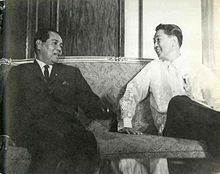Stonehill scandal
The Stonehill scandal, named after American expatriate businessman Harry Stonehill,[1] was a 1962 bribery scandal in the Philippines which implicated high level government officials, including President Diosdado Macapagal,[2] future President Ferdinand Marcos,[2][3] former President Carlos P. Garcia,[3] and numerous other top Philippine officials, who were accused of accepting bribes to protect Stonehill's $50-million business empire, which included a monopoly on tobacco and other exploited crops and popular local resources.
The raid resulted in the confiscation of phone-tapping instruments, jamming devices, and other espionage equipment as well as six army trucks worth of documents.
"[4] Some friends of Macapagal even sent death threats to Diokno, prompting Manila Mayor Arsenio Lacson to offer him special protection.
[9] The scandal is reputed to have cost Macapagal his presidency, where he lost by a landslide to another friend bribed by Stonehill in Ferdinand Marcos during the 1965 Philippine presidential election.
Harry Steinberg, a Polish-American war veteran who went by the Anglicized surname Stonehill was in charge of a 50 million US dollar empire, which involved bribed officials and monopolies on different industries from tobacco including the top brand, "Puppies", to cement and glassware.
Spielman, fearing for his life, shared information of a certain "blue book" that could serve as crucial evidence in the hearing and in potential charges.
Some including President Macapagal himself, received up to three million pesos in 1961, among the two hundred listed names of politicians in the blue book.
[14] It would not be until 1967 that the case would be reopened and this time ruled with finality on the usage of the seized materials sans the blue book as evidence for investigation.
This can be found in the Bill of Rights of the 1935 Constitution, or in Article III, Section 1(3) which states, (3) The right of the people to be secure in their persons, houses, papers, and effects against unreasonable searches and seizures shall not be violated, and no warrants shall issue but upon probable cause, to be determined by the judge after examination under oath or affirmation of the complainant and the witnesses he may produce, and particularly describing the place to be searched, and the persons or things to be seized.
[16] This is reiterated in the far lengthier prevailing 1987 Constitution, which emphasized that the term "search and seizures" were of any nature or type, as well as the personal involvement of the judge as a result of this case.SECTION 2.
This was because the protection of the right to privacy may be violated, which is the essence of the exclusionary rule or the doctrine of the fruit of the poisonous tree.
Essentially the rule also ensured that general warrants or scatter-shot warrants cannot be issued to allow law officers to go on fishing expeditions and obtain evidence against the accused, as this is the only practical means to enforce the constitutional injunction against unreasonable searches and seizures in the Bill of Rights found in Article III of both the contemporary and modern constitutions.
During this excursion, he returned to home soil in 1987, one year after the People Power Revolution that ousted President Marcos, subtly revisiting the country in order to seek out his assets but was quickly made to leave, gaining nothing in his short visit.
Stonehill eventually died in Málaga, Spain in March 2002, at the age of 84, long after the lifetimes of Senator Diokno, Presidents Macapagal and Marcos, and many other parties involved.
[5] The case has become a metaphor for presidents who choose to hide pieces of evidence in corruption allegations that may implicate them, and has become a model of comparison used by political analysts for corruption scandals such as in the Pharmally inquiry involving President Rodrigo Duterte[21] and the PDAF or Pork barrel scam involving Janet Napoles.
[20] Though Stonehill may have lost possession of his 50 million dollar empire which included at least 18 known companies, some of the effects of his ventures include the casinos and establishments along Pasay City, which takes a huge section of what is called Bay City attached to Manila and facing Manila Bay.






